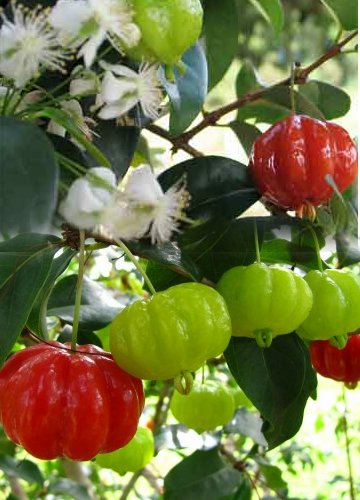
|
|
Suriname cherry
(Eugenia uniflora). Flowers and fruits.
|
Suriname cherry - Eugenia uniflora
Eugenia uniflora, with common names Pitanga, Suriname cherry, Brazilian cherry, Cayenne
cherry, or Cerisier Carre is a plant in the family Myrtaceae, native to tropical South America’s east
coast, ranging from Suriname, French Guiana to southern Brazil, as well as parts of
Paraguay, Argentina and Uruguay. Known as pitanga throughout Brazil and
Uruguay, or nangapiri in surrounding countries, the plant is relatively pest
resistant, easy to grow and high in antioxidants. The tree is also grown in the West
Indies, specifically in Haiti, where it is known as Cerisier Carre, as is in French
Guiana. The Suriname cherry is often used in gardens as a hedge or
screen. The tree was introduced to Bermuda for ornamental purposes but is now out of control and listed as an invasive
species. In Suriname this cherry is known as Monkimonki Kersie, also Montjimontji
Kersie.
Eugenia uniflora is a large shrub or small tree with a conical form, growing slowly to 8 meters in
height. The leaves are opposite, ovate-lanceolate up to 4 cm long.
New leaves are bronze, copper or coppery-pinkish in color, maturing to a deep glossy
green. During winter the leaves turn red. The leaves contain aromatic oils of
citronella, cineole, terpenine, sesquiterpenes and others.
The Surinam cherry flowering may occur several times a
year, with a single moderate sized tree having thousands of flowers.
The flowers have long stalk and appear single or in groups of four together in the leaf
axils. The flower has delicate white petals, 50 to 60 white stamens and
pale-yellow anthers.
Flowers develop into ribbed fruits 2 to 4 cm in diameter
The fruit is a berry with 7 to 8 ribs, green-orange in the beginning, turning
bright-red or deep scarlet with maturity and becoming almost black when fully
ripe. The flesh is orange-red, very juicy and a sweet-acid taste. The fruit
contains one large round seed or sometime 2 or 3 small light brown seeds. Fruiting is generally profuse with hundreds or thousands of fruits per cycle and trees sometimes fruiting 2-3 times a
year. There are some named varieties with most bearing red fruits. There are also lesser
known, black ripening types.
The Surinam cherry is adapted to both subtropical and tropical climates and is hardy to 22F when full
grown.
Plants like full sun and are drought tolerant, needing only moderate rainfall. Fruits develop and ripen in just 3-4 weeks from
flowering. In subtropical and tropical climates the tree needs little care and seems to grow in most soil
types. Irrigation is necessary in areas with minimal or seasonal
rainfall. Propagation álmost always by seed, little attention is given to selection of superior
varieties. Red type and black type forms usually come true to seed.
The edible fruit is a botanical berry. The taste ranges from sweet to sour, depending on the cultivar and level of ripeness
(the darker red to black range is quite sweet, while the green to orange range is strikingly
tart). Its predominant food use is as a flavoring and base for jams and
jellies. Children enjoy eating the ripe fruits out-of-hand. They are also sprinkled with sugar to release the juice and they are used in
shortcake, fruit cups, salads, custard pudding and ice cream. Often, they are made into
jam, jelly or relish. In Brazil, the juice is fermented into vinegar or
wine, and sometimes prepare as liquor. The fruit is high in vitamin C and a source of vitamin A.
Because of their resinous content, the seeds should not be eaten. Dogs fed on fruits with seeds have developed
diarrhea.
Eugenia uniflora has several significant pharmacological properties. Its essential oil is
antihypertensive, antidiabetic, antitumor and analgesic, and it has shown antiviral and antifungal
activity. It has performed against microorganisms such as Trichomonas gallinae
(in vitro), Trypanosoma cruzi and Leishmania amazonensis.
It also shows significant anti-inflammatory properties, and is used extensively as a folk remedy in South America against stomach
diseases. In Brazil the leaf infusion is taken as a febrifuge and astringent and for stomach
problems. In Surinam, the leaf decoction is drunk as a cold remedy and, in combination with
lemongrass, as a febrifuge.
When bruised, crushed or cut, the leaves and branches of Eugenia uniflora have a spicy resinous
fragrance, which can cause respiratory discomfort in susceptible
individuals. In Brazil, the leaves are spread over and when walked
upon, they release their pungent oil which repels flies. The bark contains tannin and is used for treating
leather. Surinam Cherry is also used for bonsai and in landscaping as
hedges.
Source:
https://en.wikipedia.org/wiki/Eugenia_uniflora
http://www.tradewindsfruit.com/content/surinam-cherry.htm
http://ntbg.org/plants/plant_details.php?plantid=5067
